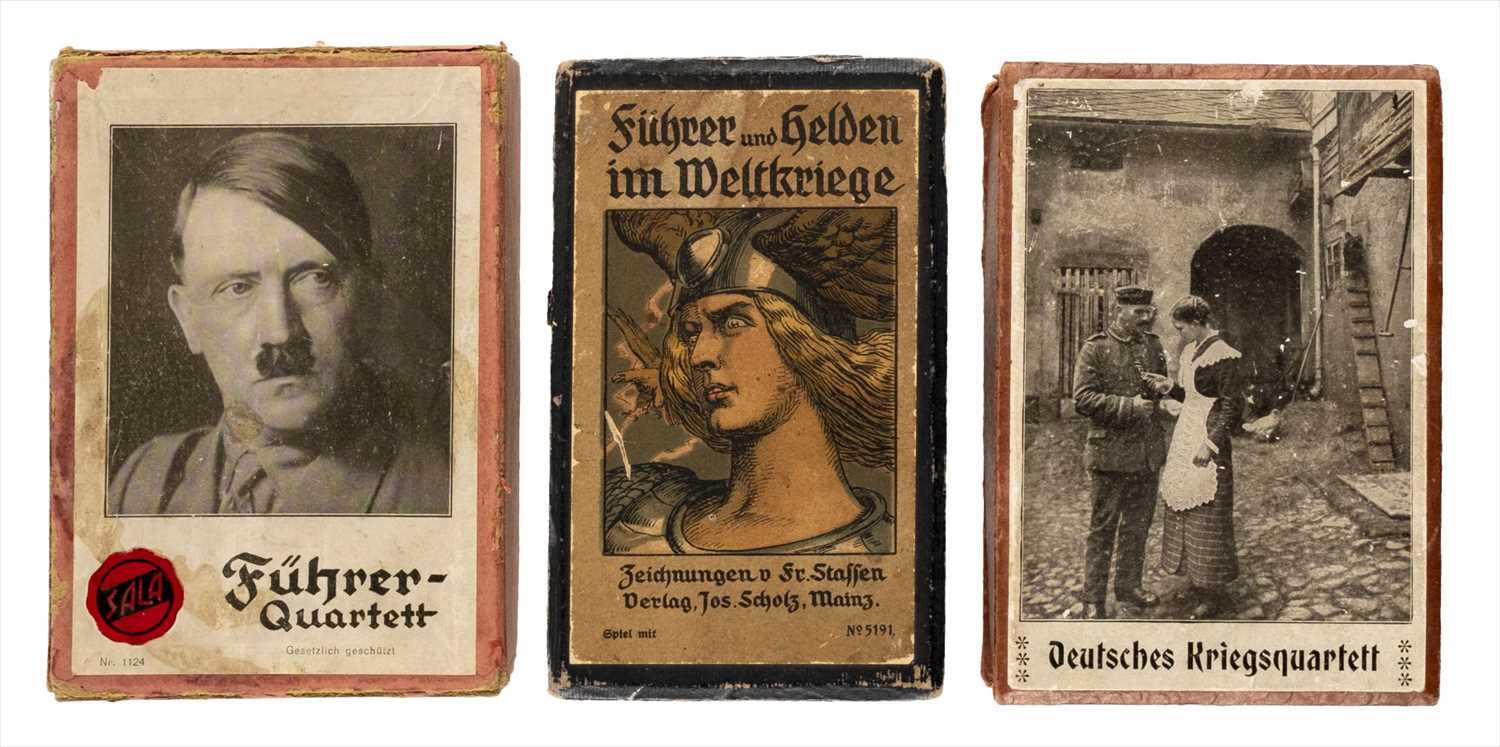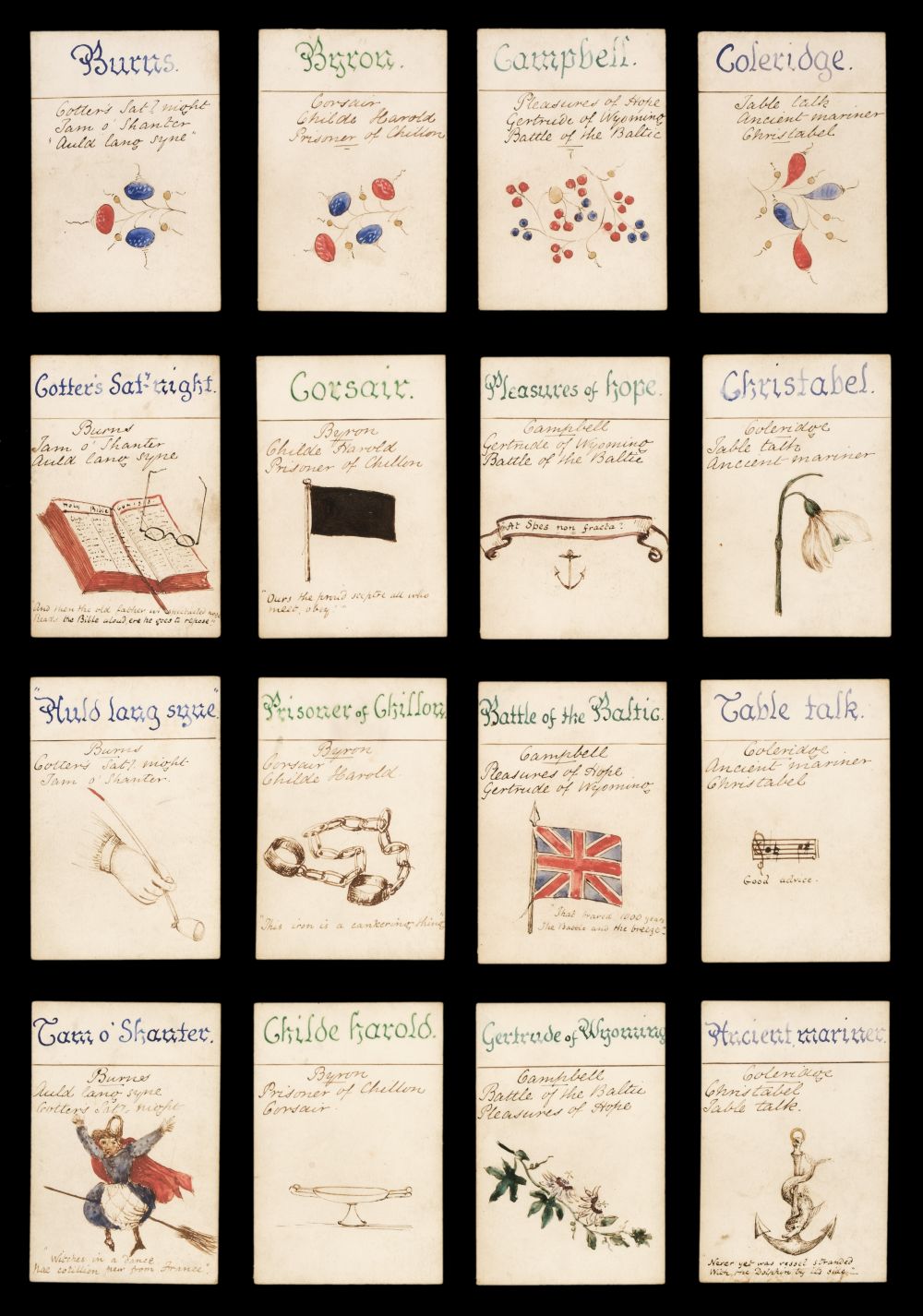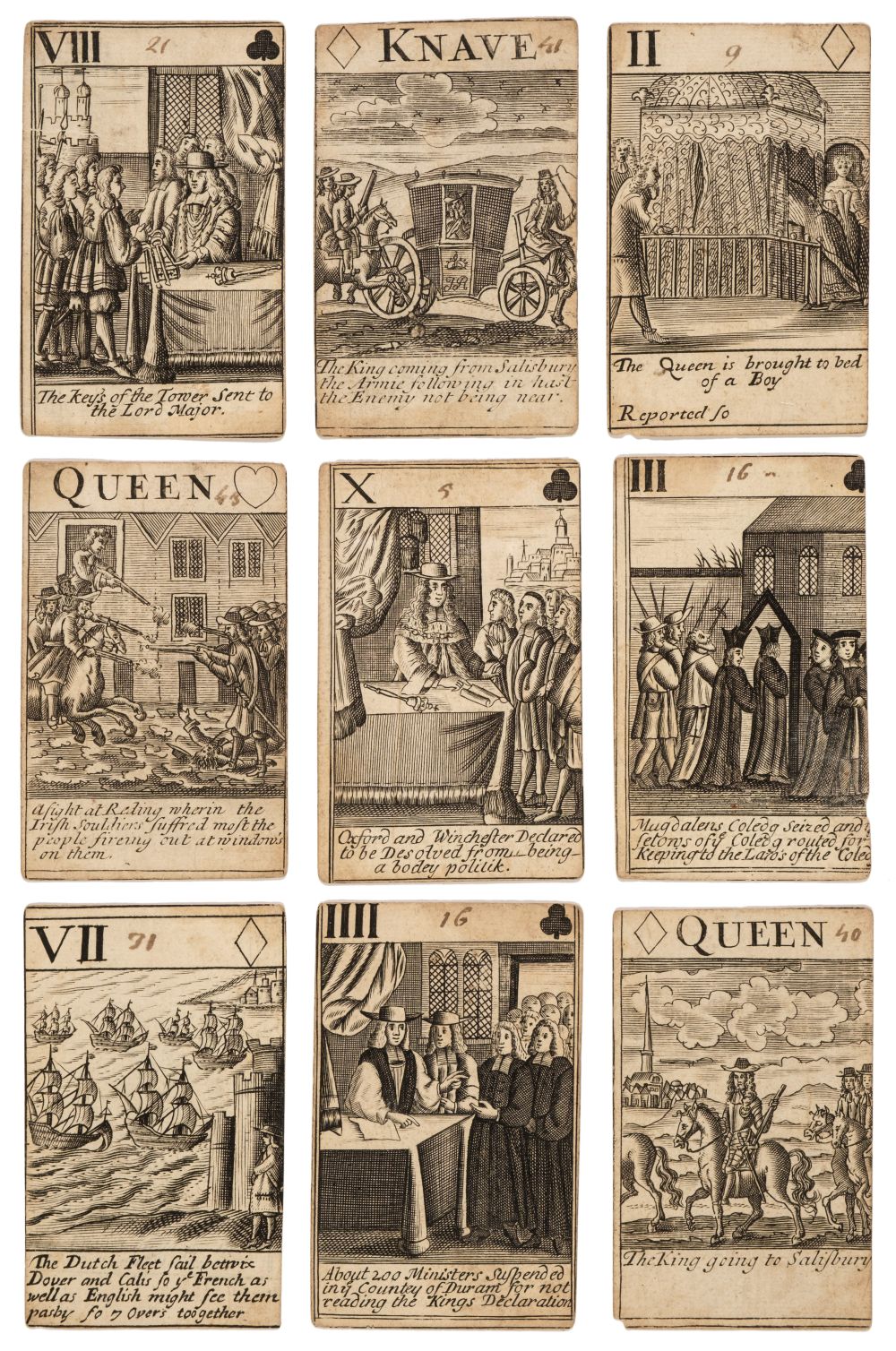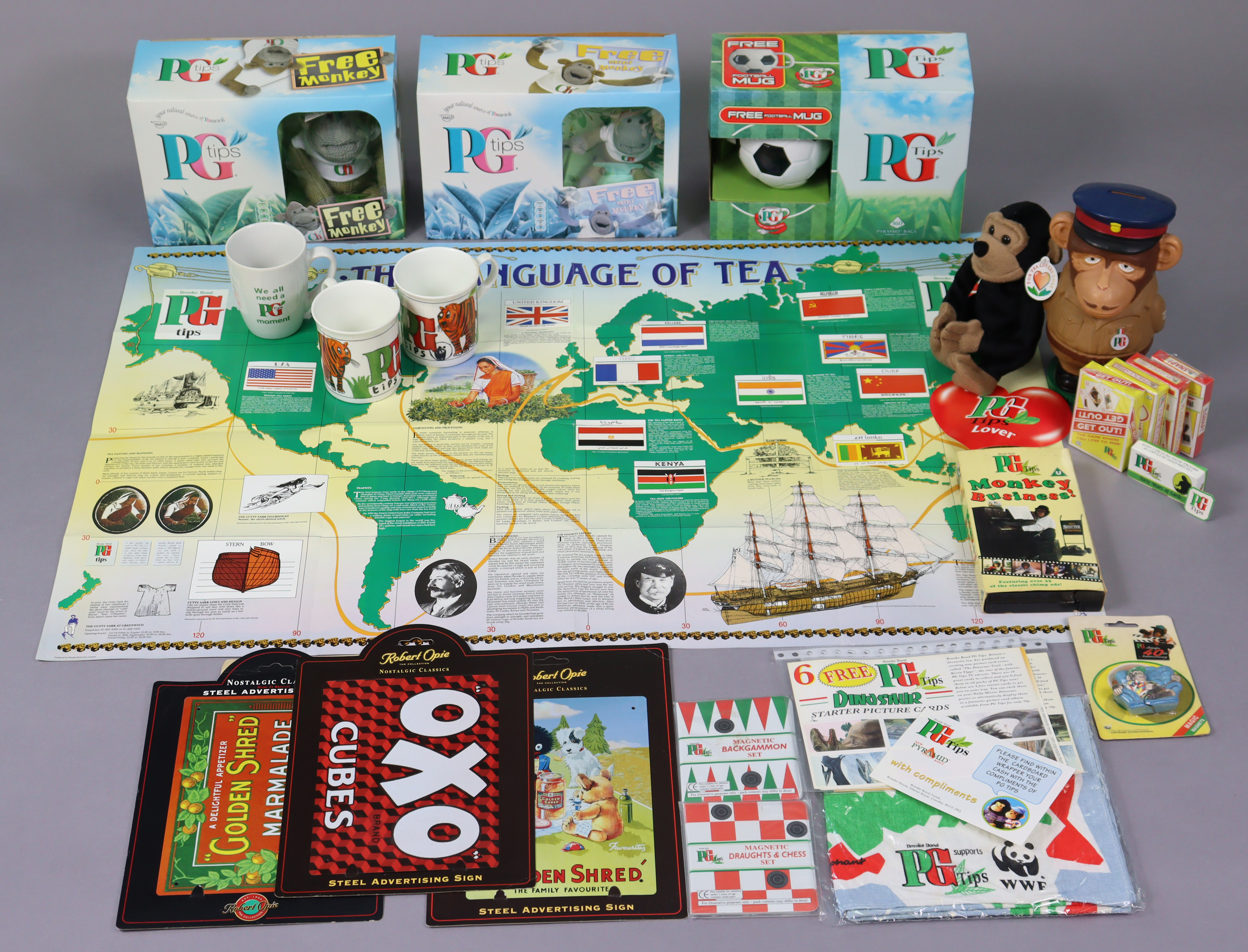PLAYING CARDS]. Three sets of French seventeenth-century heraldic playing cards, one complete, one colored, c. 1658-1700. Together 119 engraved cards, on stiff thin cardboard cut out around square borders (platemarks cropped), each c. 88 x 56 mm. (3 1/2 x 2 3/16 in.), backs plain, the 8 and 10 of diamonds in set 1 stained, a few other minor stains or soiling . CONTENTS 1) CLAUDE ORONCE FINÉ DE BRIANVILLE, engraver . [Jeu de Blason. Lyons, c. 1658]. FIRST EDITION, 19 (of 52) cards, French suits, ALL WITH CONTEMPORARY HAND-COLORING, each card with the arms of a European kingdom, province, or dignitary; comprising: 2-10 and Jack (Prince) of Spades, 3 and 7 of Clubs, 8-10 and Ace (Chevalier), Queen (Dame) and King (Roi) of Diamonds. Cary Collection FRA 283 (containing 41 cards only, lacking the Jack of Spades, present in this set); Hargrave, pp. 61-62; not in the British Museum. 2) C. ORONCE FINÉ DE BRIANVILLE, engraver . [Jeu de Blason. Lyons, c. 1667]. Third or fourth edition of no. 1 above, complete pack of 52 cards, uncolored, showing the principal arms of Europe, King of Clubs with the arms of Pope Clement IX (1667-1669). Cary Collection FRA 284-5; not in BM. 3) Pack of heraldic playing cards, [Lyons?, c. 1700]. 48 (of 52) engraved cards, suits: the fleur-de-Lys for France, the eagle for Germany and Flanders, the rose for Italy, and the lion for Spain and Portugal, armorial bearings on each card except the court cards, which show portraits of the sovereigns of each realm, while the Aces show the Pavillons of respectively France, the German Empire, Savoie, and Portugal, the numbers of the lower cards being indicated by the number of bearings depicted. Lacking Lion 3 and 6, and Fleur-de-Lys 4 and 8. Apparently a later imitation of a "Jeu de Cartes du Blason" engraved by C. F. Menestrier, published in Lyons by Thomas Almaury in 1692 (cf. Hargrave pp. 61-62); not in Cary Collection. Playing card suits as we know them seem to have originated in France in the sixteenth-century. It was perhaps a natural step from the use of court cards showing generic kings, queens and knaves to the depiction of actual historic or living figures of royalty. The production of the first heraldic cards in the last half of the seventeenth century signaled the onset of a vogue in France for historical, geographical, and mythological playing cards, used for educational purposes. De Brianville's Jeu de Blason , intended for the instruction of the young nobility and gentry in the basics of heraldry, is the earliest example in the Cary collection of French historical playing cards, and may be the earliest example known of any French instructional cards. An earlier issue contained slightly different designations of the court cards, "in which the Aces & Knaves, 'les As et Valets', were represented by the arms of certain princes et nobles. Now, as this was evidently a breach of etiquette and a derogation of heraldic nobility... the plates were seized by the magistrates. As it appeared, however, that [de Brianville] had given offence through pure inadvertence and not in any satirical intention, the plates were restored to him on condition of his altering the odious names of 'As' and 'Valets' into Princes and Chevaliers" (Chatto, pp. 150-51). Most editions of this popular series -- of which there were at least eight -- seem to have been published with small duodecimo explanatory volumes. REFERENCES Cary Collection [full ref.]; Wm. A. Chatto, Origin and History of Playing Cards , London 1848; C. P. Hargrave, A History of Playing Cards , Boston & New York 1930; W. H. Willshire, A Descriptive Catalogue of Playing and other Cards in the British Museum , Amsterdam 1975, pp. 43-44. (119)
PLAYING CARDS]. Three sets of French seventeenth-century heraldic playing cards, one complete, one colored, c. 1658-1700. Together 119 engraved cards, on stiff thin cardboard cut out around square borders (platemarks cropped), each c. 88 x 56 mm. (3 1/2 x 2 3/16 in.), backs plain, the 8 and 10 of diamonds in set 1 stained, a few other minor stains or soiling . CONTENTS 1) CLAUDE ORONCE FINÉ DE BRIANVILLE, engraver . [Jeu de Blason. Lyons, c. 1658]. FIRST EDITION, 19 (of 52) cards, French suits, ALL WITH CONTEMPORARY HAND-COLORING, each card with the arms of a European kingdom, province, or dignitary; comprising: 2-10 and Jack (Prince) of Spades, 3 and 7 of Clubs, 8-10 and Ace (Chevalier), Queen (Dame) and King (Roi) of Diamonds. Cary Collection FRA 283 (containing 41 cards only, lacking the Jack of Spades, present in this set); Hargrave, pp. 61-62; not in the British Museum. 2) C. ORONCE FINÉ DE BRIANVILLE, engraver . [Jeu de Blason. Lyons, c. 1667]. Third or fourth edition of no. 1 above, complete pack of 52 cards, uncolored, showing the principal arms of Europe, King of Clubs with the arms of Pope Clement IX (1667-1669). Cary Collection FRA 284-5; not in BM. 3) Pack of heraldic playing cards, [Lyons?, c. 1700]. 48 (of 52) engraved cards, suits: the fleur-de-Lys for France, the eagle for Germany and Flanders, the rose for Italy, and the lion for Spain and Portugal, armorial bearings on each card except the court cards, which show portraits of the sovereigns of each realm, while the Aces show the Pavillons of respectively France, the German Empire, Savoie, and Portugal, the numbers of the lower cards being indicated by the number of bearings depicted. Lacking Lion 3 and 6, and Fleur-de-Lys 4 and 8. Apparently a later imitation of a "Jeu de Cartes du Blason" engraved by C. F. Menestrier, published in Lyons by Thomas Almaury in 1692 (cf. Hargrave pp. 61-62); not in Cary Collection. Playing card suits as we know them seem to have originated in France in the sixteenth-century. It was perhaps a natural step from the use of court cards showing generic kings, queens and knaves to the depiction of actual historic or living figures of royalty. The production of the first heraldic cards in the last half of the seventeenth century signaled the onset of a vogue in France for historical, geographical, and mythological playing cards, used for educational purposes. De Brianville's Jeu de Blason , intended for the instruction of the young nobility and gentry in the basics of heraldry, is the earliest example in the Cary collection of French historical playing cards, and may be the earliest example known of any French instructional cards. An earlier issue contained slightly different designations of the court cards, "in which the Aces & Knaves, 'les As et Valets', were represented by the arms of certain princes et nobles. Now, as this was evidently a breach of etiquette and a derogation of heraldic nobility... the plates were seized by the magistrates. As it appeared, however, that [de Brianville] had given offence through pure inadvertence and not in any satirical intention, the plates were restored to him on condition of his altering the odious names of 'As' and 'Valets' into Princes and Chevaliers" (Chatto, pp. 150-51). Most editions of this popular series -- of which there were at least eight -- seem to have been published with small duodecimo explanatory volumes. REFERENCES Cary Collection [full ref.]; Wm. A. Chatto, Origin and History of Playing Cards , London 1848; C. P. Hargrave, A History of Playing Cards , Boston & New York 1930; W. H. Willshire, A Descriptive Catalogue of Playing and other Cards in the British Museum , Amsterdam 1975, pp. 43-44. (119)















Try LotSearch and its premium features for 7 days - without any costs!
Be notified automatically about new items in upcoming auctions.
Create an alert